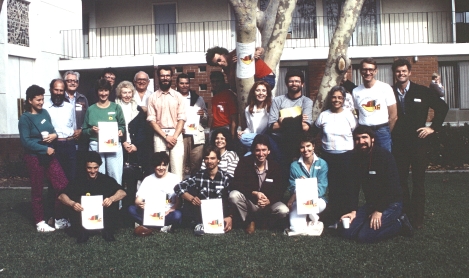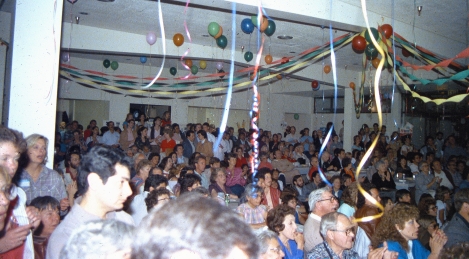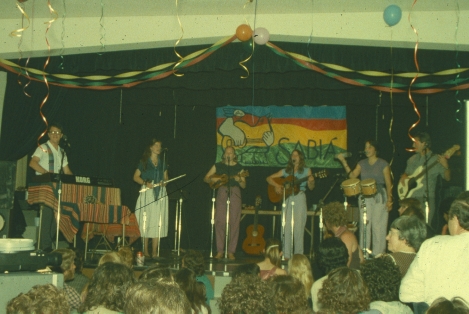|
Why a March for Peace in Central America?
In January, 1983, representatives of Panama, Mexico,
Colombia, and Venezuela decided to take a big risk: the active promotion of a Latin American,
negotiated alternative to President
Reagan’s contra war against Nicaragua. Their over-riding concern was to prevent a U.S. invasion of
Nicaragua, and the region-wide conflict that would certainly result from such an invasion. The four
countries became known as the Contadora group, after the Panamanian island on which they met. Later,
the Contadora four would be supported by the Lima Support Group — Brazil,
Peru, Uruguay, and Argentina — and their efforts to build a regional peace plan would be hailed around
the world. Quoted material following is from various Christian
Science Monitor (CSM) reports on the Contadora peace process.
The Contadora group's earliest plan was “a three-tier approach that may offer something to all
sides:
* A twin set of bilateral talks (Nicaragua-Honduras and Nicaragua-US).
* A trilateral meeting (Nicaragua-Honduras-Salvador).
* A multilateral meeting with all the Central American states represented (under the auspices of the Contadora
group).” [CSM, May 11, 1983]
In late October, 1983, Contadora persuaded the five Central American nations—Guatemala, Honduras,
Nicaragua, El Salvador, and Costa Rica—to sign “a 21-point
agreement of basic principles for peace...” This success gave “new prestige to the Contadora groups as a
forum in which further efforts for peace in the region might be achieved. ... The 21 points represented
a breakthrough, because for the first time all parties to the Central American
conflict, including Nicaragua, had agreed on general principles for a settlement. The principles call for:
verifiable arms reduction, patrolling of borders to stop the flow of guerillas and arms, withdrawal of all
foreign advisers, respect for human rights, and the establishment of democratic governments in all countries.”
[CSM, January 4, 1984]
Talks continued toward forging the 21-points into a peace plan that all countries could live with, but, as I
understand it, the Sandinistas refused to accept certain demands that they felt encroached on their
sovereignty. Then, the Sandinistas surprised everyone:
“Junta coordinator Daniel Ortega Saavedra says Nicaragua is ready to ‘accept in its totality and sign
immediately’ the Contadora group's regional peace plan — if the United States ‘halts its aggression against
Nicaragua.’ He said on Friday night that there will be no peace in the region until the US signs the
Contadora plan, and until then, Nicaragua will continue to ‘take the necessary measures’ to defend itself.
“The 21-point plan calls for the demilitarization of Central America and an end to outside interference. It has
been approved in principle by El Salvador, Guatemala, Costa Rica, Honduras, and Nicaragua. But they have not
agreed on specifics.” [CSM, September 24, 1984]
Well now. What’s a super-power to do when caught off guard like that? Put pressure on its client states to find flaws
in the plan, of course. And that's just what the "Washington three" did:
“US seen as responsible for the slowdown in Contadora peace talks"
“The Reagan administration scored a victory for itself in Central America last week when the Contadora peace
talks bogged down.
“For weeks it had seemed that only minor modifications remained to be made on the draft regional peace treaty.
But at a meeting of most of the interested parties last Friday, representatives of three
countries - Honduras, El Salvador, and Costa Rica - suddenly said extensive changes were required before
they could accept the plan.
“The three countries' objections came after a short but intensive lobbying effort by the Reagan administration,
say several United States and Central American diplomats and analysts.” [CSM, October 26, 1984.]
For its part, the State Department proposed the knee-slapper that it had not been following the
negotiations with enough diligence to catch these flaws ahead of time. Predictably, the objections by the
“Washington three” successfully derailed the peace process:
“The Central American peace negotiations known as the Contadora talks have
suffered a sharp setback.
“The indefinite postponement of the Contadora meeting planned for Thursday
and today has put the whole peace process into deep freeze for at least
several months, according to well-informed foreign policy analysts here.”
...
“In October, El Salvador, Honduras, and Costa Rica came up with a
counterproposal at a Contadora meeting in Honduras. This called for the
withdrawal of Cuban advisers before the withdrawal of other advisers in the
region.
“The counterproposal also called for verification to be carried out, not by
the Contadora four, but by the Central American countries themselves.
...
Nicaragua, as was expected, refused to sign the revised agreement. So the
Contadora process entered a period of stagnation.
"During the winter ... the Contadora four ... urged the US allies to
modify their stand and accept a compromise agreement more acceptable to the
Nicaraguans. However, ... the Central American countries, supported by the US, refused to budge."
[CSM, February 15, 1985. Note the phrase "supported by the US," instead of the more truthful "forced by the US."]
La Marcha Por La Paz En Centroamerica is born
It was during this period of stagnation that La Marcha was conceived. The idea was to show
international support for the Contadora process through a high-profile, six-week journey from Panama City
to Mexico City. (In truth, we would "march" mostly in the cities and towns, between which we would ride
in buses. Oh well.)
The inspiration for La Marcha was the launching of a peace ship from Norway to Nicaragua in July of 1984.
The idea itself was suggested by a Norwegian Central America expert. After successful discussions between
Norwegian peace activist Torill Eide and her Central American counterparts, December 1984 - January 1985,
the official committee was formed in Norway in March, 1985. During June and July, other Norwegian organizers
went to Central America to begin work on the logistical details.
There were enthusiastic peace communities in every Central American country except Guatemala, where it was simply
too dangerous to be openly supportive of such an effort. Even so, Salvadoran and Honduran activists were not
blasé about their situation. To march organizers' expressed concerns that the presence of international
peace activists might put them in danger, they said "we're in danger anyway; we want you to come."
Along with support for Contadora, La Marcha would stress two other themes: Self-determination for all the
nations of Latin America, and Solidarity with, and between them. It was hoped that hundreds of international
peace activists would sign up for the March, and planning for an unknown number of participants was a
major effort. As of October of 1985 it was not clear that La Marcha could effectively go foward, but the
organizing committee heroically pulled it off.
For those who might want to learn more about that era, I recommend the Christian Science Monitor’s archived
reports on Contadora. The Monitor charges less for its archived articles than do the other mainstream papers.
Below I've included a few photos to introduce some of the members of La Marcha, and to show a small
fraction of the people in the Los Angeles area working for peace and self-determination in Central America.
On the country pages (to be developed), along with additional information, I try to show the profound decency and
humanity of los marchistas; a decency and humanity utterly lacking in the Reagan
administration, and nowhere to be found, of course, in CIA headquarters at Langley, Virginia.
Even though President Reagan was ultimately successful in sabotaging the Contadora peace process,
La Marcha at least caused his minions some uncomfortable moments. (These same minions, of
course, made sure that no cloud of truth ever cast a shadow over President Reagan's sunny dispostion, although
most of us in the peace movement cannot accept the excuse made for him that he was not aware of the monstrous,
even pathological cruelties he had sanctioned against the poor of Central America.)
|
 Not long before we leave for Panama, a few prospective marchistas pose outside the headquarters
of then Santa Monica-based Office of the Americas(OOA),
the peace organization founded by Blase and Theresa Bonpane.
Not long before we leave for Panama, a few prospective marchistas pose outside the headquarters
of then Santa Monica-based Office of the Americas(OOA),
the peace organization founded by Blase and Theresa Bonpane. A typical fund-raiser at the Office of the Americas. OOA's office was at the Episcopal Church in
Santa Monica.
A typical fund-raiser at the Office of the Americas. OOA's office was at the Episcopal Church in
Santa Monica.
 The nueva canción (new song) quartet SABIÁ was a major force in the peace movement.
The nueva canción (new song) quartet SABIÁ was a major force in the peace movement.